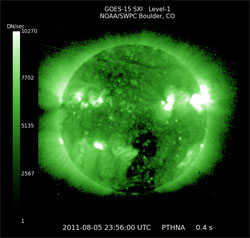Space weather prediction model improves NOAA’s forecast skill

An X-ray image of the Sun from August 5, captured by a NOAA satellite. Three successive coronal mass ejections - big blasts of plasma from the Sun - exploded from a bright region near far right (circled in additional image). Impacts on Earth were minimal: temporary high-frequency radio outages in a few regions, minor distortion of global positioning system signals and no known power outages or satellite damage. (Credit: NOAA)<br>
Explosions in the sun’s outer atmosphere – tracked and forecast by NOAA scientists – can cause geomagnetic and solar radiation storms at Earth that can impede the operation of electrical power grids, interfere with the normal function of Global Positioning Systems and temporarily hamper radio and satellite telecommunications. Grid and satellite operators and airlines can take protective measures when stormy conditions are forecast.
“This advanced model has strengthened forecasters’ understanding of what happens in the 93 million miles between Earth and the sun following a solar disturbance,” said Tom Bogdan, director of NOAA’s Space Weather Prediction Center in Boulder, Colo. “It will help power grid and communications technology managers know what to expect so they can protect infrastructure and the public.”
Magnetic storms can occur on Earth 1–4 days after a coronal mass ejection – a burst of charged particles and magnetic field that streams out from the sun at more than one million miles an hour. Before development of this model, forecasters could predict timing of such impacts within a 30-hour window, on average. The new model allows forecasters to narrow that window to 12 hours.
That improvement gives airline operators more reliable information about when to reroute flights to avoid communications blackouts from storms. Satellite operators can avoid changing orbit or orientation when space weather threatens. Oil drilling, mining and other operations that rely on global positioning systems – which can be made unreliable by space weather – can avoid conditions that might put operators at risk. Power companies can work to prevent problems.
“The shorter prediction timeframe will enable the electric industry to better prepare for potential issues,” said Gerry Cauley, president and chief executive officer of the North American Electric Reliability Corporation. “The continued improvement of forecasting through innovation and modernization of the existing satellite infrastructure is vital to support the reliability of North America’s bulk electric system.”
The new model, WSA-Enlil, combines two advanced models, the Wang-Sheeley-Arge (WSA) and Enlil (named for the Sumerian god of wind). These linked numerical forecast models simulate physical conditions and phenomena from the base of the sun’s corona out into interplanetary space, to Earth and beyond. Space weather scientists “inject” solar events into the WSA-Enlil model to understand how the space weather storm system is likely to unfold.
Scientists with NOAA, NASA, the Air Force Research Laboratory, the Cooperative Institute for Research in Environmental Sciences (CIRES) at the University of Colorado at Boulder, Boston University, the National Center for Atmospheric Research and George Mason University collaborated to develop the model.
The model has been used in experimental mode for several months and has accurately forecast the timing of recent space weather events. NOAA began running the new model on its supercomputers officially on September 30. Recent model run results are available online.
NOAA’s Space Weather Prediction Center in Boulder, Colo. is the nation’s official source of operational forecasts, warnings and alerts about space weather.
NOAA’s mission is to understand and predict changes in the Earth's environment, from the depths of the ocean to the surface of the sun, and to conserve and manage our coastal and marine resources. Join us on Facebook, Twitter and our other social media channels.
Media Contact
All latest news from the category: Physics and Astronomy
This area deals with the fundamental laws and building blocks of nature and how they interact, the properties and the behavior of matter, and research into space and time and their structures.
innovations-report provides in-depth reports and articles on subjects such as astrophysics, laser technologies, nuclear, quantum, particle and solid-state physics, nanotechnologies, planetary research and findings (Mars, Venus) and developments related to the Hubble Telescope.
Newest articles

Silicon Carbide Innovation Alliance to drive industrial-scale semiconductor work
Known for its ability to withstand extreme environments and high voltages, silicon carbide (SiC) is a semiconducting material made up of silicon and carbon atoms arranged into crystals that is…

New SPECT/CT technique shows impressive biomarker identification
…offers increased access for prostate cancer patients. A novel SPECT/CT acquisition method can accurately detect radiopharmaceutical biodistribution in a convenient manner for prostate cancer patients, opening the door for more…

How 3D printers can give robots a soft touch
Soft skin coverings and touch sensors have emerged as a promising feature for robots that are both safer and more intuitive for human interaction, but they are expensive and difficult…





















